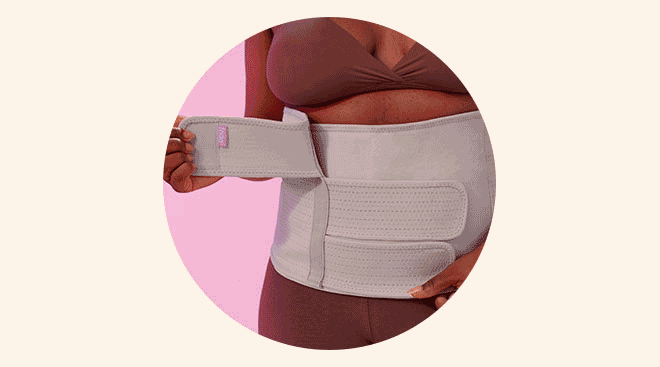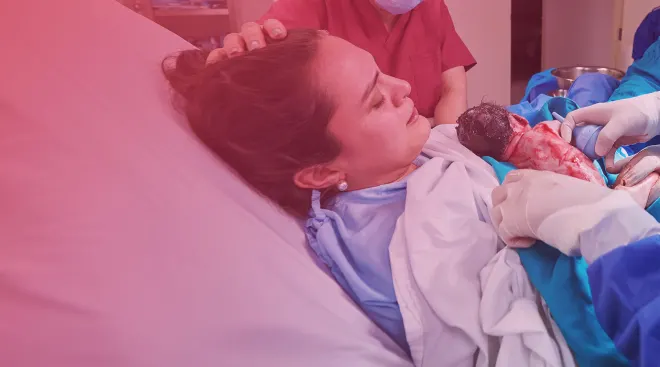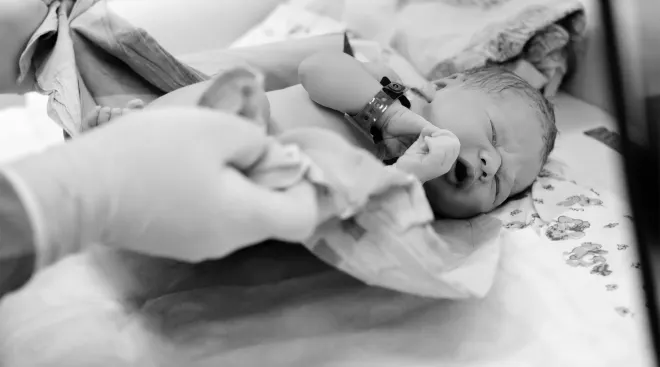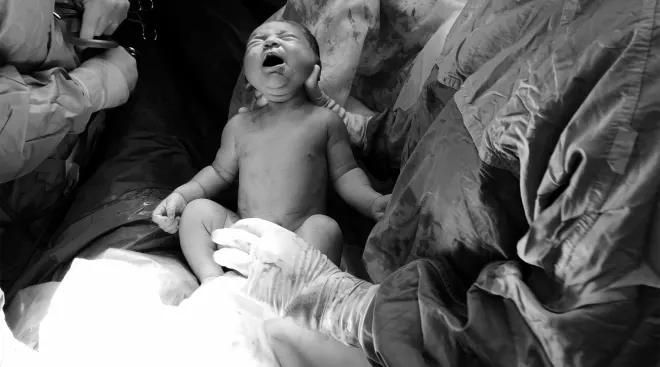13 Things No One Tells You About C-Sections
Chances are, if you’ve scheduled a C-section, you’ve done your homework. You know what a C-section entails and what your options might be to make it more comfortable. Maybe you even viewed some videos online and curated your music playlist. But despite painstaking preparation, a slew of things can still catch you by surprise. And, of course, for many moms a C-section isn’t part of their birth plan, but rather an in-the-moment necessity.
“Because they get a little bundle at the end, people sometimes forget that this is still a major surgery,” says New York-based ob-gyn Kameelah Phillips, MD, an ob-gyn in New York City—and as a result, they also don’t realize the big and small things that often happen when you undergo this type of procedure. So we’ve asked OBs, as well as moms who’ve been there, to give you a no-holds-barred heads-up about the unexpected truths of a X-section delivery and recovery.
If you have a spinal block, your body might experience spasms—a common reaction to the medication. It may feel strange, but “it’s nothing excessive,” says Carolyn Eskridge, MD, an ob-gyn with Island Women’s Care in Pawleys Island, South Carolina. It’s more of a “light shiver,” she explains, and it should go away as the anesthesia wears off.
My first C-section was because I wasn't dilating any more after two days of labor. Epidural was already in so it was rather ‘easy.’ The second C-section was scheduled and definitely different. I walked into the OR and there was a little delay in getting epidural in. That was the scariest part. But I held both babies shortly after birth and nursed both. I'd definitely do a scheduled C-section again.
Your cesarean won’t hurt a bit, thanks to the anesthesia you’ll be given—but you’ll still have some sensation. “The goal of anesthesia is to take away pain, sharpness and pinching,” Phillips says. “But you’ll still feel touch.” You might feel a pushing and tugging sensation as your doctor eases baby out of the uterus, especially if your little one has been curling up near your rib cage. Some doctors, like Phillips, like to let their patients know beforehand that “what the mom is feeling is my body weight maneuvering the baby out.”
While it’s natural to think you feel cold because the room is cold (after all, operating room temperatures are typically low to keep things sterile), Eskridge says doctors actually raise the temperature for C-sections in order to accommodate baby. So the real reason why you might feel cold is that you’ve been numb from the waist down, half-naked and lying still for 30 minutes—and it only feels colder when doctors remove your surgical drapes at the end of surgery, Phillips notes. Don’t feel shy about speaking up; often, you’ll can get warm blankets to cover you up.
I was awake all through the process talking with my doctors and the staff. I was numbed from my abdomen down after getting an injection at my back. I felt when my baby was removed and heard his cry, and then he was shown to me.
Well, sort of. Actually, your legs will be fitted into contraptions called sequential compression devices (SCDs), which inflate and deflate to improve circulation and prevent blood clots, per University of Washington Medical Center. So it might kind of feel like a massage. SCDs are often slipped on before surgery, and they stay on for much of your stay except when you’re taking a walk, which is another good way to stave off clots and keep your blood flowing.
Even though it wasn’t baby’s exit route, your vagina is still an important part of your recovery. Lori, a mom and The Bump community member, jokingly calls it the “vaginal car wash,” as it’s a post-delivery peri-bottle rinse and dry-cloth pat down to clean up any blood leaking after the surgery (more on that below). If your labor started out vaginally but switched to a C-section partway through, you may experience more bleeding and, therefore, require more cleansing. In this case, a small sponge may be inserted to clean the inside of your vagina. This “helps minimize the risk of infection,” says Phillips.
You won’t have as much postpartum bleeding as with a vaginal delivery (since the vaginal cavity is wiped clean at the time of your surgery), but bleeding will still happen. “It’s the way the uterus cleans itself out after delivery, and it’s completely normal,” Phillips explains. Your uterine wall is healing itself after the placenta has detached. Your blood vessels are responding to hormone fluctuations. That thick lining that grew to support baby throughout your pregnancy is shedding. Don’t worry, though—any bleeding should last only up to six weeks.
I was surprised… I figured since baby didn’t come out vaginally, I wouldn’t bleed (boy, was I wrong).
Postpartum swelling, medically known as edema, is pretty common regardless of how you deliver baby. It happens due to the fluid retention and hormonal changes that occur immediately after birth, explains Sherry Ross, MD, an ob-gyn, women’s sexual health expert and co-founder of Oneself Intimate Skin Care. You’ll notice it around your C-section incision, as well as in your legs, feet, arms and hands. Rest assured, it’s completely normal and will go down a few weeks after delivery. To help the swelling go down faster, drink lots of water, elevate your feet and wear compression garments.
You may believe C-sections prohibit the ability for skin-to-skin contact with baby, but that’s not the case. “After a C-section of an uncomplicated pregnancy, a healthy baby can be placed on mom’s chest to have skin-to-skin contact if desired,” Ross notes. However, if you want kangaroo care prior to baby being wrapped in a blanket, you’ll want to request it with your operating team ahead of time so they can prepare for it, she adds. Breastfeeding, however, will have to wait until both mom and baby are in the recovery room following the surgery.
Pooping can be a problem post C-section, since it’s tough to push when your abdomen is tender and sore. “Even though we don’t cut abdominal muscles, it’s still engaging your core, which is weak,” Phillips explains. Plus, it’s hard not to think that pushing will bust your abdominal stitches (though that’s not going to happen, Phillips reassures, even if it feels as if everything is opening up). That’s why she highly recommends taking stool softeners after delivery, which will help ease you back into your routine. Of course, drinking lots of water and walking around as soon as you can after the C-section will greatly ease the poop situation too.
When your bowels become sluggish after surgery, gas can press on the diaphragm, trigger a nerve and extend the pain to the shoulders. Phillips says people primarily feel a sharp, shooting sensation on the right side. To combat this, your nurse will probably offer you anti-gas meds and encourage you to walk around as soon as possible post-surgery (usually after a day). Another cause for shoulder aches, adds Eskridge, is something called “referred pain”—pain that arises from one part of the body (in this case, the uterus) but is felt in another. Whatever the cause, your shoulder should feel better in a day or so.
My C-section was emergent, so it was quick. I was out like a light because of my epidural and don't remember much. I remember throwing up, hearing my daughter cry and then waking up in recovery. Recovery was quick because it had to be. Baby was in the NICU for 18 days, and I wasn't missing out on any of that time. I ended up having to walk most of the time, because nurses were in short supply and couldn't wheel me down. Having had both types of birth, I would choose C-section again.
It may surprise you to feel pain when you sneeze or cough after a C-section. But Eskridge, who underwent two C-sections of her own, experienced the same thing—and offers some useful advice: “Splinting (holding a pillow against the abdomen over the incision) is very helpful in preventing pain with coughs, sneezes and laughing,” she says. Keep a pillow handy in all rooms and when you’re riding in a car. Belly bands or other compression garments can also help support your abs, since applying pressure to your muscles after they’ve been cut will help combat the pain that comes from muscle contractions. Expect the worst pain in the week following delivery, after which it’ll gradually subside over the course of a few more weeks.
Each C-section scar is different—it may be horizontal or vertical, and it usually sits right above your pubic hairline. But some moms admit they didn’t realize just how prominent their scar would be. The important thing is to not put anything on your scar for six weeks, otherwise you’ll risk infection. Just let it heal. After that, if you want the scar to fade faster, Eskridge suggests trying scar-fading ointments, though the scar might not disappear completely. Regardless of how effective they are, Phillips points out that it’s hard for most women to apply them consistently when they have a new baby. “You’re going to heal the way you’re going to heal,” she says, “and it’s okay.”
I felt totally disfigured, but over time, it faded and flattened out a lot, and now I actually love it. It’s my Mommy battle scar!
Yes, you just had major surgery and you need to rest and recover. But getting up and hobbling around as soon as humanly possible is a good idea. (Most doctors recommend the day after your surgery, but of course, wait until yours gives you the green light.) “Once the spinal wears off and movement is back in the lower extremities, it’s safe to walk around,” Eskridge says. “It gets the bowels working again and can prevent a lot of gas pain.” It also helps prevent blood clots. Phillips advises making a point to get out of bed every few hours. “Take yourself to the bathroom instead of using a bedpan and walk up and down the hallway with support,” she says. “Push yourself, within reason.”
At the end of the day, while C-sections are a method of childbirth, they’re also a big surgery that can take time to heal from. “The first few days following a C-section are the most challenging, since the body is going through major physical, emotional and hormonal transitions,” Ross says. “Take it slow, don’t overdo it and have realistic expectations.” Plus, remember that everyone’s journey postpartum looks different—and that’s okay. “Don’t pressure yourself to get your pre-pregnant body back and create other expectations that you may not achieve,” Ross adds. “Life usually gets back to normal as everyone adjusts with an open mind, patience and understanding.”
Please note: The Bump and the materials and information it contains are not intended to, and do not constitute, medical or other health advice or diagnosis and should not be used as such. You should always consult with a qualified physician or health professional about your specific circumstances.
Plus, more from The Bump:
Carolyn Eskridge, MD, is an ob-gyn with Island Women’s Care in Pawleys Island, South Carolina. She earned her medical degree from Louisiana State University School of Medicine in 1992.
Kameelah Phillips, MD, is a New York City-based ob-gyn affiliated with Lenox Hill Hospital and the founder of Calla Women’s Health. She received her medical degree from Keck School of Medicine of USC and has been practicing for over a decade.
Sherry Ross, MD, is an ob-gyn and women’s sexual health expert. She’s the author of She-ology: The Definitive Guide to Women’s Intimate Health. Period. and She-ology, The She-quel: Let’s Continue the Conversation. She’s also the co-founder of Oneself Intimate Skin Care and the Women's Health & Wellness School on the Mproov app. She earned her medical degree from New York Medical College and completed her residency at University of Southern California School Of Medicine.
University of Washington Medical Center, After Your Cesarean Birth, September 2016
Learn how we ensure the accuracy of our content through our editorial and medical review process.
Navigate forward to interact with the calendar and select a date. Press the question mark key to get the keyboard shortcuts for changing dates.




















































